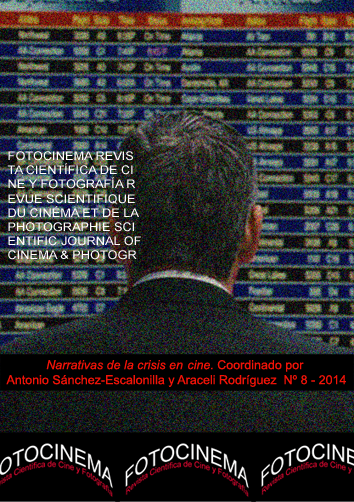The Horrors of Slavery and Crisis of Humanity in Amistad and 12 Years a Slave
DOI:
https://doi.org/10.24310/Fotocinema.2014.v0i8.5944Resumen
Solomon Northup’s testimonial 12 Years a Slave (1853) tells the heart-wrenching story of how a free black man living in New York was captured by slave traders and forced to live as a slave on southern plantations in the 1840s under inhuman and oppressive conditions. Writing up and publishing his experiences, Northup presents a searing portrayal of the evils of slavery that influenced abolitionist arguments and movements in the pre-Civil War period as debates over slavery intensified, leading to the bloodiest war in American history.The horrors of slavery created a crisis of humanity in the United States in which a class of Americans participated in slave-holding, a practice that was seen in some parts of the country as causing a crisis of humanity in which millions were subjected to inhuman living working and living conditions. While the U.S. constitution and American revolution had produced “liberty and justice for all,” and proclaimed equal rights before the law obviously the system of slavery created a crisis for U.S. constitutional democracy that led to a Civil War that almost tore the country apart. Hollywood cinema has traditionally been reluctant to portray the horrors of slavery, providing idealizations of slavery in films like Birth of a Nation (1915) and Gone with the Wind (1939), and tending to ignore it during the highly charged post-World War II period that featured an intensifying powerful Civil Rights movement.
Steve McQueen’s 2013 film provides a powerful cinematic rendition of Northup’s 12 Years a Slave and has been affirmed as one of the one most powerful films on slavery ever produced, a film being nominated for and winning multiple awards as I write in winter 2014. In this article, I will contrast Gordon Parks’ relatively unknown PBS “American Experience” film of 1984 Solomon Northup’s Odyssey with McQueen’s film, although I open with a look back at Steven Spielberg’s Amistad (1997), which presents a 1839 slave revolt on a ship bound to the Americas and the subsequent trial of the rebels. The Amistad rebellion and trial, like Northup’s book, influenced the abolitionist movement and is a significant, although often forgotten moment in U.S. history. Hence, the current discussions of McQueen’s highly acclaimed film provide the opportunity for a look backwards at a painful moment in U.S. history and for discussion of different modes of cinematic representation of slavery and how a crisis of humanity in the U.S. has received different modes of cinematic representation. Accordingly, I will contrast Spielberg’s film with Parks’ and McQueen’s presentations of slavery in their versions of Northup’s 12 Years a Slave. Although Spielberg’s Amistad contains many features of dominant American ideology and an individualist Hollywood narrative which informs Spielberg’s liberal cinema, it is perhaps the most modernist and one of the most compelling of Spielberg’s films that deserves a second look and comparison with Park and McQueen’s 12 Years a Slave.
I will, however, first examine Amistad which provides a broader panorama of the system and complex effects of slavery in U.S. life and history than Parks’ powerful narrative of Northup’s book and McQueen’s more concentrated and intense focus on the horrors of slavery in 12 Years a Slave. I contrast Parks’ use of classical realist modes of representation with McQueen’s aestheticized and modernist version. Juxtaposing different cinematic representations of slavery and cinematic renditions of Northup’s slave testimony, I show how McQueen’s film provides a modernist version of Northup’s text that forces the audience to experience the horrors of slavery and crisis of humanity, while Parks uses a conventional realist narrative to tell Northup’s story and depict the institutions of slavery. These films, I believe, are among the best English-language cinematic efforts to engage the “peculiar” and arguably monstrous American institution of slavery that continues to shape our history today into the Obama era.
Palabras clave: Esclavitud; Crisis de la humanidad; Narrativas de la crisis; Hollywood; Steven Spielberg; Steve McQueen
Keywords: Slavery; Crisis of Humanity; Narratives of Crisis; Hollywood; Steven Spielberg; Steve McQueenDescargas
Métricas
Publicación Facts
Perfil de revisores N/D
Información adicional autores
Indexado: {$indexList}
-
Indexado en
- Sociedad Académica/Grupo
- N/D
- Editora:
- Universidad de Málaga
Descargas
Publicado
Cómo citar
Número
Sección
Licencia
Todos los contenidos publicados en Fotocinema. Revista científica de cine y fotografía están sujetos a la licencia Creative Commons Reconocimento-NoComercia-Compartirigual 4.0 cuyo texto completo puede consultar en <http://creativecommons.org/licenses/by-nc-sa/4.0>
Se pueden copiar, usar, difundir, transmitir y exponer públicamente, siempre que:
- Se cite la autoría y la fuente original de su publicación (revista, editorial y URL de la obra).
- No se usen para fines comerciales.
- Se mencione la existencia y especificaciones de esta licencia de uso.
Los derechos de autor son de dos clases: morales y patrimoniales. Los derechos morales son prerrogativas perpetuas, irrenunciables, intransferibles, inalienables, inembargables e imprescriptibles. De acuerdo con la legislación de derechos de autor, Fotocinema. Revista científica de cine y fotografía reconoce y respeta el derecho moral de los autores/as, así como la titularidad del derecho patrimonial, el cual será cedido a la Universidad de Málaga para su difusión en acceso abierto. Los derechos patrimoniales, se refieren a los beneficios que se obtienen por el uso o divulgación de las obras. Fotocinema. Revista científica de cine y fotografía se publica en open access y queda autorizada en exclusiva para realizar u autorizar por cualquier medio el uso, distribución, divulgación, reproducción, adaptación, traducción o transformación de la obra.
Es responsabilidad de los autores/as obtener los permisos necesarios de las imágenes que están sujetas a derechos de autor.














13.png)



